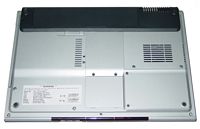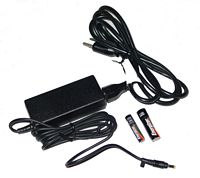HP Pavilion DV1000 Entertainment Notebook PC - Multimedia Notebook A Breed Apart
by Jason Clark on October 2, 2004 11:03 AM EST- Posted in
- Laptops
Construction - Build, Appearance, Size (cont.)
The display lid of the notebook is secured to the base by two female security tabs, which can be released by a single clip located in the center of the notebook.Front (left to right):
- power status (blue when active)
- hard drive activity (blue when active)
- battery (blue when charging)
- microphone port
- headphone port 1
- headphone port 2
Unlike many notebook designs, however, the lip of this notebook is angled up, which provides the user with better than average multimedia audio experience from their Harmon/Kardon speakers. While the brand of the speaker is supposed to tell you a lot, the implementation of speakers on a notebook is nevertheless an obstacle when you want to develop a good audio source. That being said, these speakers were up to par with our expectations, surpassing the quality of other multimedia notebooks. We would probably compare them to the quality of mid-range desktop speakers.
We used them in our entertainment room with our TV running at mid-level volume, so that you could clearly hear the TV volume from 15ft while sitting on the couch. With our DV1000 about 5ft away and set to a volume setting of 16 (the max), two of us could pay attention to Matrix Reloaded well and follow the storyline without losing ourselves in the TV audio. Though, we could actually switch and pay attention to what was on TV when there weren't too many explosions going off from the DVD.
Other notebooks that we have seen from IBM and Dell are angle down toward whatever surface the notebook will be sitting on. The problem with a downward angle approach is that the sound isn't directly meeting your ears. Instead, it is dubbed a bit when it bounces off the surface first. We have to say that for a multimedia notebook, HP definitely has the audio design down the way we prefer it, in terms of practically, end results, and general design.
Otherwise, layout comes as expected with a few minor differences than what we are use to seeing. For one, there are two headphone ports, as opposed to one. This becomes useful when you want to watch a movie with someone else. With one headphone port, the only way to share the audio experience is to pipe it through the speakers, thereby disturbing others around you. While you can get a Y-splitter for the one headphone jack, it isn't the same as having two available jacks. The design of an additional jack actually doesn't take up any degree of real estate, so this wasn't a design hurdle.
The other big difference from other notebooks is the implementation of a high-density pin connector for the expansion base, which we will get to in the latter part of the review. The main difference here is that most notebooks have their docking connection on the bottom.
Left (left to right):
- VGA out port
- Expansion base connector
- Ethernet jack
- Modem jack
- USB 2.0 port
- PCMCIA port
- Kensington lock port
Back (left to right):
- Exhaust vent
- Power port
Back (left to right):
- USB 2.0 port
- Flash media reader (SD/MS/MS Pro/MMC/SM/XD)
- 4-pin mini IEEE1394 port
- Flash media LED (blinking blue when active)
- NEC DVD+RW ND-5100A
- S-video out port
- USB 2.0 port
The size of the DV1000's charger is fairly similar to ones for other notebooks, like Acer's Aspire 2020, and is the same model as the charger for HP's own NC6000 business notebook.
While the DV1000 doesn't implement a modular bay design like their NC6000 and other similar notebooks, it does offer extended battery life via a larger battery pack (10.8V 8.8AH Lithium-Ion). Note that its use isn't in combination with the standard battery pack (10.8V 4.4AH Lithium-Ion). The only noticeable physical difference is that the laptop will tilt on a further angle because the battery pack protrudes out a bit with its somewhat "S" shape.
We don't currently know the price for the purchase of the extended battery, but apparently, HP is going to offer shoppers the ability to upgrade from the standard battery to the extended battery for $25 dollars extra when they place an order. As a separate purchase, we aren't quite sure what the list price is.
The two vents on the bottom seem to be intake vents for the system.
 Click to enlarge. |
 Click to enlarge. |
Measuring in at 9.1" x 13.1" x 1.3" thick, the DV1000 is one of the smaller multimedia notebooks that we have seen. While it is only slightly shorter than Dell's Inspiron 8600 in width, the shorter display cuts down the length dimensions noticeably. Marking its weight at slightly over 5 pounds (~5.26 lbs. give-and-take, depending on what is loaded on the notebook), it puts it on the heavier end of many mainstream notebooks, but in our opinion, it isn't too heavy that you can't take it on your trips. Far from it, this is one of the most mobile multimedia notebooks that we have seen this year.
















10 Comments
View All Comments
Biochem101 - Thursday, October 28, 2004 - link
Ohh yeah, just to add.The dv1040us machine has at the minimum the following specs:
Centrino 725 1.6GHz CPU 2mb cache
64 mb shared video memory (cry, but im dealing with it)
Those are the only differnces that stand out from the AT review model.
Biochem101 - Thursday, October 28, 2004 - link
I just picked one of these puppies up for ~1100 AR. When I was shopping, I was looking for a very portable laptop with some performnce. So far I love it. The screen seems to have a built in anti-glare film similar to the film used on my Sony Trinitron CRT. It provides adequate glare relief in most situations. I did notice the font blur and was somewhat dissappointed with that problem. But all in all, I found a compact, light and relatively powerful laptop with great battery performance. I havent done any performance tests on the machine yet (its the 1.6G version - dv1040us model), but I doubt there will be much difference between my machine and he one AT has reviewed here.imho- im glad a ran across this review, I was just looking for some info on the general performance of the chipset in the machine, not a machine specific review. KUDOS to AT for souping up their number of reviews.
Pete - Sunday, October 24, 2004 - link
BTW, the glare on this laptop was pretty harsh when I viewed it in CompUSA, although there was a very bright fluorescent light directly behind my shoulder. My eyes got tired looking at it after 15 mins, whereas the "regular" LCD on the Toshiba next to it was *very* easy to read.It's not just that the dv1000's screen was glossy, either. Cleartype fonts looked kind of blurry or oily, not nice at all. Actually, it's possible the screen was something like BGR, and Cleartype was set for RGB subpixel smoothing. I'll have to look into that, as the screen is this laptop's Achilles heel, and one too big for me to ignore.
Pete - Sunday, October 24, 2004 - link
No, but a faster video card will, and the BenQ Joybook 7000 has the same formfactor and screen with a Mobility Radeon 9700 to boot! I'm convinced that would sell like hotcakes here, and I'm not sure why either HP or BenQ haven't started selling them here. Apparently this Intel IGP scores 2.5K in 3DM2001, not even 2003--frickin' abysmal. I'm not even sure it'd be fast enough for something like Age of Mythology or Warcraft 3 at this screen's native res.Andrew, start pushing Anandtech's weight around to get a laptop with this formfactor and discrete graphics in the USA! :)
airfoil - Thursday, October 7, 2004 - link
Quote: "but for another $100 or $150, you can configure your DV1000 with a 1.7GHz Pentium-M 735 or 1.8GHz Pentium-M 745, respectfully."Respectfully? Does a faster prcoessor buy more respect?
trikster2 - Monday, October 4, 2004 - link
#3 that's really strange. 2gb just to play a DVD sounds excessive#4 Not sure who the ODM is but there is a Benq Joybean that is identicle
#3 my main reservation with this notebook is the brightview or whatever screen. The ones I've seen on sony and fujitsu's at frys have a lot of glare. I dumped my CRT for an LCD due to glare (lots of windows) would hate to be fighting glare on a glossy laptop screen too.
In comparison to a CRT, how bad is the glare on this laptop?
Thanks!
SDA - Sunday, October 3, 2004 - link
Question-- who makes this notebook? (I know it has an HP sticker, but IIRC HP don't make their own notebooks like.) I ask because I'd like to see if there are any nearly identical no-name equivalents available.AndrewKu - Saturday, October 2, 2004 - link
#2 - Windows is reading it wrong.Scarceas - Saturday, October 2, 2004 - link
The article says a 2GB partition is used for the quickplay system.The screen shot shows 204MB. 204MB seems more reasonable. Might want to update that.
CasmirRadon - Saturday, October 2, 2004 - link
Sounds great, if/when my old Presario notebook craps out on me in the next year or so this will be the kind of form-factor/functionality that I will be looking for. My friend just got a Pavillion, and I must say that it makes me jealous if only for the exceedingly convenient placement of headphone/usb ports. That is the kind of feature that many of us forget to look for when shopping for a notebook, but makes all the difference after extended use.